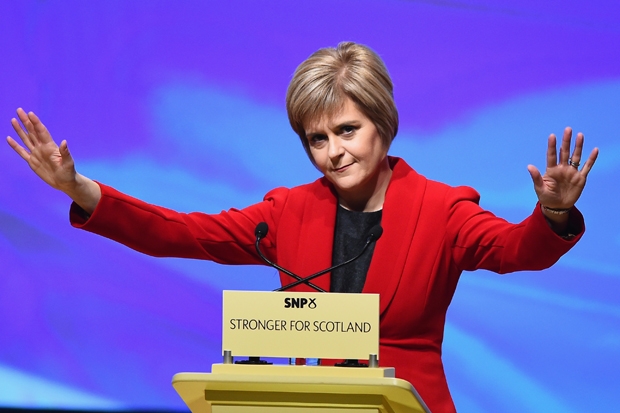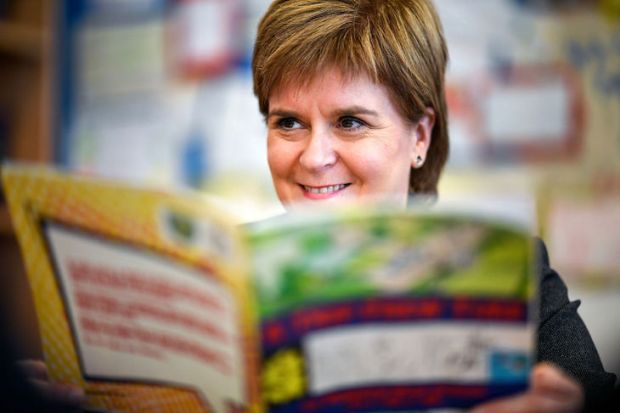This is the time of year when economists and political scientists make their predictions for the upcoming 12 months. Will we finally see the back of Covid and economic recovery? Will Boris Johnson survive as prime minister?
In Scotland, the politerati are speculating on what Nicola Sturgeon’s next move on the constitution will be. It seems likely the Scottish government will introduce a bill, without the agreement of Westminster, on a second independence referendum. This is expected to be challenged at the UK Supreme Court. The most likely outcome of that is the referendum bill failing on the grounds that it goes beyond the constitutional powers of the devolved parliament — a UK Supreme Court caseearlier this year reinforced the view this will be the most probable conclusion.
At the same time, Nicola Sturgeon has announced that Scottish civil servants will be tasked with working on a ‘detailed prospectus’ for exiting the UK. And so we will see Scotland move into its eighth year of constitutional showboating while the day-to-day matters of governance — the stuff that actually impacts people’s lives — is neglected.
It will be pure theatre, but maybe now, finally, even the true believers will see it as such. The impassioned speeches in the Scottish Parliament as the bill is introduced; the firing up of the SNP’s army of communications staff and their online followers to create a sense of momentum — it’s all very predictable. Sometimes, though, repetition with no delivery dilutes effectiveness and credibility to the point where grandstanding looks merely comical. This is surely the point Sturgeon’s administration has reached.
And then there will be the pretence that the Scottish government’s new white paper on separation is designed to inform. The official 2014 referendum document, Scotland’s Future, did not provide voters with dispassionate analysis of the impact voting to leave the UK would have on their lives. Far from it. It pitched a dream — an unattainable fantasy, parts of which would have come back to haunt Alex Salmond and Sturgeon had separation happened. There is nothing to suggest the new analysis from the Scottish government will be any different.
There is an alternative. If the Scottish government is determined to put state resources to work outlining a future for the people of Scotland in an independent country, then a credible way to do that would be to formally task the Scottish Fiscal Commission (SFC), the independent body that produces economic and fiscal forecasts for the government, with modelling a seceded Scotland scenario in its regular publications.
Why the SFC and why their models? For one, the SFC has shown itself to be credibly independent from government. Also, it has the technical expertise to do the analysis. And a look at what it already produces shows it could deliver the relevant scenario analysis efficiently. This could save taxpayer money compared with the Scottish government’s plan, which will likely see the production of a lengthy new document long on platitudes and obfuscation, and short on hard facts.
Take for example the Scottish government’s regularly-published Medium-Term Financial Strategy (MTFS), which sees the SFC project the Scottish government budget for the next five years under various scenarios based on assumptions about the future — for instance, in the past its ‘lower scenario’ assumes the UK government adopts a tight fiscal stance in future years. Nicola Sturgeon aims to have a referendum before the end of 2023 — ‘Covid permitting’. We can therefore conclude that her intention is for Scotland to be fully fiscally autonomous sometime in 2025 (Scotland’s Future presupposed it would happen two years after the vote, and the 2018 SNP Growth Commission report, aimed at refreshing the separation case, assumed a similar timeline).
It surely makes sense for the SFC to take this into account in projections that go into the likes of the the MTFS, at least as one scenario. It is certainly technically achievable. Most of the work on fiscal autonomy is already being done as part of the production of theannual Government Expenditure and Revenue Scotland (Gers) numbers. The SFC could take this and supplement it with realistic assumptions around the borrowing capacity the new state would have, and from there forecast a budget position.
In some ways it is extraordinary that the SFC isn’t already modelling the fiscally autonomous scenario in its projections through 2025/26, given the current Scottish government’s official policy is to end UK fiscal transfers at that point, and that this is within the period of the current parliament.
Cutting Scotland off from UK funding would have a dramatic impact on Scottish budget forecasts. A truthful modelling of that might not fit with Nicola Sturgeon’s aim of showboating on the constitution while misinforming people on the reality of secession.
That’s why honest analysis, which we could have from the SFC, is something we’re unlikely to see.
Got something to add? Join the discussion and comment below.
Get 10 issues for just $10
Subscribe to The Spectator Australia today for the next 10 magazine issues, plus full online access, for just $10.



















Comments
Don't miss out
Join the conversation with other Spectator Australia readers. Subscribe to leave a comment.
SUBSCRIBEAlready a subscriber? Log in